Valparaíso (Chile) 作者: 来源: 发布时间:2021-06-03
1.Population and Area
Valparaíso is a major city, seaport, naval base and educational centre in the commune of Valparaíso, Chile. "Greater Valparaíso" is the second largest metropolitan area in the country. Valparaíso is located about 120 kilometres (75 mi) northwest of Santiago by road and is one of the South Pacific's most important seaports. Valparaíso is the capital of Chile's second most populated administrative region and has been the headquarters for the Chilean National Congress since 1990.
Population: 284,630(2012)
Area: 401.6 km2 (155.1 sq mi)
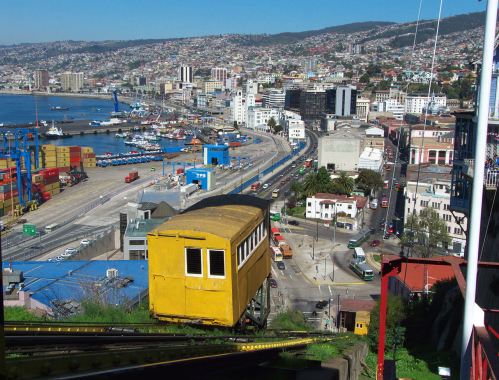
2. Geography
Valparaíso is located in central Chile, 120 km (75 mi) to the north west of the capital Santiago. Because of Valparaíso's proximity to the Peru–Chile Trench, Valparaíso, like most of Chile, is vulnerable to earthquakes. Before the earthquake of February 27, 2010, which measured 8.8 on the moment magnitude scale, the last catastrophic earthquake to strike Valparaíso devastated the city in August 1906, killing nearly 3,000 people. Other significant earthquakes to affect the city were the 1730 Valparaíso earthquake and the 1985 Algarrobo earthquake.
Transportation
A commuter rail service, the Valparaíso Metro, opened to the public on 24 November 2005. The creation of this system involved updating parts of the Valparaíso-Santiago Railway, originally built in 1863. The Valparaíso Metro constitutes the so-called "fourth stage" ("Cuarta Etapa") of Metropolitan improvements. The Metro now connects the city core of Valparaíso with Viña del Mar and other cities. It extends along most of Gran Valparaíso, and is the second underground urban rail system in operation in Chile (after Santiago's), as it includes an tunnel section that crosses Viña del Mar's commercial district. The proposed Santiago–Valparaíso railway line would link Valparaíso and Santiago in around 45 minutes.
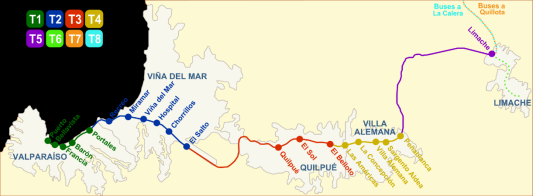
Metro Valparaiso Map
Public transport within Valparaíso itself is provided primarily by buses, trolleybuses and funiculars. The buses provide an efficient and regular service to and from the city centre and the numerous hills where most people live, as well as to neighbouring towns while more distant towns are served by long-distance coaches. Buses are operated by several private companies and regulated by the Regional Ministry of Transport, which controls fares and routes. The Valparaíso trolleybus system has been in operation since 1952, and in 2019 it continues to use some of its original vehicles, built in 1952 by the Pullman-Standard Company, along with an assortment of other vehicles acquired later. Some of Valparaíso's Pullman trolleybuses are even older, built in 1946–48, having been acquired secondhand from Santiago in the 1970s. The surviving Pullman trolleybuses are the oldest trolleybuses still in normal service anywhere in the world, and they were collectively declared National Historic Monuments by the Chilean government in 2003.
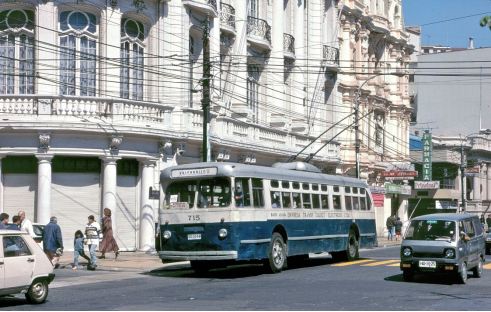
One of the historic trolleybuses that are still in daily service in 2019
Valparaíso's road infrastructure has been undergoing substantial improvement, particularly with the completion of the "Curauma — Placilla — La Pólvora" freeway bypass, which will allow trucks to go directly to the port facility over a modern highway and through tunnels, without driving through the historic and already congested downtown streets. In addition, roads to link Valparaíso to San Antonio, Chile's second-largest port, and the coastal towns in between (Laguna Verde, Quintay, Algarrobo, and Isla Negra, for example), are also under various degrees of completion. Travel between Valparaíso and Santiago currently takes about 80 minutes via a modern toll highway.
Internal passenger air services to Valparaíso are provided through the airport at Quintero which is some distance from the city but now served by good roads. The great majority of foreign visitors arrive through Santiago or on cruise liners.
Funiculars
Because of the slopes of the hills, many of the surrounding areas of Valparaíso are inaccessible by public transport. That is why "elevators" serve the function of communicating the high part of the city with the plan, besides being a strong holiday highlight. The only elevator that can truly be called as such, is the Ascensor Polanco, because it is vertical. Meanwhile, the rest are cable cars but traditionally called elevators. Several of those funiculars – locally called ascensores – provide public transport service between the central area and the lower slopes of the surrounding hills, the first of which (Ascensor Concepción, also known as Ascensor Turri) opened in 1883, operated by steam, is still in service. The Cerro Cordillera elevator was built in 1887. As many as 28 different funicular railways have served Valparaíso at one time or another, of which 14 were still in operation in 1992 and still around 12 in 2010.
Technically most of these elevators are bona fide funiculars. Only one of them, the Ascensor Polanco, is a true vertical elevator. They were mainly constructed in the late 19th and early 20th centuries.
3. Economy
Major industries of the city include tourism, culture, shipping and freight transport. Approximately 50 international cruise ships call on Valparaíso during the 4-month Chilean summer. The port of Valparaíso is also an important hub for container freight and exports many products, including wine, copper, and fresh fruit.
In 2011, GDP at 2008 prices per capita for the region of Valparaíso was 4,370.39 thousand pesos.
4. Industries
Industry of shipping and freight transport(Port of Valparaíso)
Valparaíso is the main container and passenger port in Chile, transferring 10 million tons annually, and serves about 50 cruises and 150,000 passengers.
The port of Valparaíso is divided into ten sites which sites 1,2,3,4 and 5 are administered by South Pacific Terminal SA and sites 6,7,8,9 and 10 for Valparaíso Port Company. The last two sites include a dock and are used as public walks and cruise passenger terminal.
Overlooking the port of Valparaíso from the viewing point 21 de Mayo (May Twenty-one), Artillery Hill.

Commerce
There are two large shopping centres and various other major retail developments:
Portal Valparaíso (Jumbo/Easy/Paris/La Polar)
Harbour Station Shopping Mall
Paseo Ross Shopping Mall
Kenrick Mall
Axis Avenida Pedro Montt
Axis Avenida Uruguay
Axis Avenida Condell
5. Tourist attractions
Iglesia de la Matriz
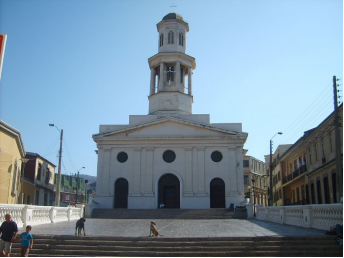
The Iglesia de La Matriz del Salvador (The Matriz Church of the Saviour) is a church located in the heart of the port district (Barrio Puerto) of the city, surrounded by cobblestone streets and houses it has a historical importance in the city and was declared a National Monument of Chile in 1971.
The church of a typical basilical style, but is built in a way to represent three ships in a rectangular fashion, separated by two waters. The main facade stands out with its classic composition. Eight columns surround the body of the church and the interior walls are decorated with zenithal paintings. There are two main influences which make up the interior of the church including this classicist style of the tower, and the 18th century Creole style represented by its great heavy walls of adobe brick and the ceiling covered with clay roofing tiles.
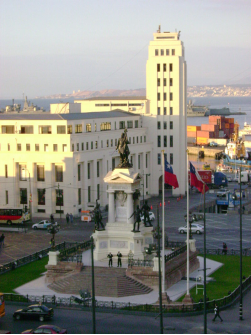
Plaza Sotomayor
The Plaza Sotomayor is a plaza in Valparaíso, Chile. It is named after Rafael Sotomayor. The square is lined by buildings occupying full block-fronts of the streets that flank it. The focus of the square is the monument that honors the Chilean sailors who fell during the Battle of Iquique and the Battle of Punta Gruesa. The plaza and surrounding buildings was designated a Zona Típica (historic district) on January 23, 1979.
At the northeastern side of the square are two similar towers, which create a sort of gate entrance to the port from the city. On the opposite side is the building that housed the Intendencia de Valparaíso, which currently is home to the headquarters of the Chilean Navy. The building used by the CSAV and the building that houses the National Council of Culture and the Arts also face the plaza.
6. History and culture
History
The city's founding remains a matter of historical controversy, although most scholars credit Juan de Saavedra (d. 1554), an officer with the Spanish explorer Diego de Almagro, who discovered the site in 1536 and named it after his hometown in Spain. The port grew in importance during the colonial period; Valparaíso was the first good stopping place for ships rounding the tip of South America into the Pacific Ocean. The colonial city also developed a flourishing contraband trade. Valparaíso was repeatedly attacked by pirates in the colonial period, and suffered seven major assaults, including attacks by Francis Drake (c. 1540–1596) in December 1578 and Richard Hawkins (c. 1562–1622) in April 1594.
In the late colonial period Valparaíso's prosperity rose with the opening of trade under the Bourbon Reforms. Following independence in 1818, commerce increased further, with Great Britain becoming the port's leading trading partner. British vessels crowded into the harbor and the English merchant community in Valparaíso grew in size and financial importance. These and other commercially active European immigrants helped to create the distinct cultural blend for which Valparaíso is still known. Disasters, both natural and human-caused, rocked Valparaíso. An earthquake in November 1822 destroyed much of the city. War with Spain brought a naval bombardment of the harbor in March 1866 that laid waste to vast sections of Valparaíso. In August 1906 a devastating earthquake and fire all but destroyed the city.
In the mid-nineteenth century Valparaíso served as the principal port for the export of Chilean wheat. The city's commercial prominence rose again after the completion of a railway to the capital in 1863, a project directed by the U.S. entrepreneur Henry Meiggs (1811–1877). For much of the second half of the nineteenth century Valparaíso was the largest city in Chile. However, the emergence of nitrate exports (a mineral used as a fertilizer and in making gunpowder), mined and shipped from the far north of Chile, diminished Valparaíso's importance in exports in the late nineteenth century. Nevertheless, the city continued as the leading port for Chilean imports, taking in roughly two-thirds of the nation's total, and still handed about one-third of Chile's exports.
The opening of the Panamá Canal 1914 diminished Valparaíso's importance. With the route around Cape Horn no longer necessary, Valparaíso became a port at the end of the world, far from principal trade routes. The slide has continued; Valparaíso is no longer even the largest port in Chile, having been eclipsed by nearby San Antonio.
Valparaíso recaptured some of its former fame when it became the seat of the Chilean congress, though the new building's design quickly became the subject of considerable criticism. In 2003 Valparaíso was named Chile's "cultural capital" by the congress.
Culture
During Valparaíso's golden age (1848–1914), the city received large numbers of immigrants, primarily from Europe. The immigrant communities left a unique imprint on the city's noteworthy architecture. Each community built its own churches and schools, while many also founded other noteworthy cultural and economic institutions. The largest immigrant communities came from Britain, Germany, and Italy, each developing their own hillside neighbourhood, preserved today as National Historic Districts or "Zonas Típicas."
During the second half of the 20th century, Valparaíso experienced a great decline, as wealthy families de-gentrified the historic quarter, moving to bustling Santiago or nearby Viña del Mar. By the early 1990s, much of the city's unique heritage had been lost and many Chileans had given up on the city. But in the mid-1990s, a grassroots preservation movement blossomed in Valparaíso where nowadays also a vast number of murals created by graffiti artists can be viewed on the streets, alleyways and stairways.
The Fundación Valparaíso (Valparaíso Foundation), founded by the North American poet Todd Temkin, has executed major neighborhood redevelopment projects; has improved the city's tourist infrastructure; and administers the city's jazz, ethnic music, and opera festivals; among other projects. Some noteworthy foundation projects include the World Heritage Trail, Opera by the Sea, and Chile's "Cultural Capital". During recent years, Mr. Temkin has used his influential Sunday column in El Mercurio de Valparaíso to advocate for many major policy issues, such as the creation of a "Ley Valparaíso" (Valparaíso Law) in the Chilean Congress, and the possibility that the Chilean government must guarantee funding for the preservation of Valparaíso's beloved funicular elevators.
Valparaíso's newspaper, El Mercurio de Valparaíso is the oldest Spanish-language newspaper in circulation in the world.
The Fundacion LUKAS maintains the drawings and paintings of the cartoonist Renzo Antonio Giovanni Pecchenino Raggi (stage name LUKAS), who came to symbolize Valparaíso in popular culture, in a new restored building overlooking the bay.
Valparaíso is also home to the so-called "School of Valparaíso", which is, in fact, the Faculty of Architecture & Urbanism of the Pontificia Universidad Católica de Valparaíso. The "School of Valparaíso" was in the 1960s and 1970s one of the most experimental, avant-garde and controversial Architectural schools in the country.
Valparaíso stages a major festival attended by hundreds of thousands of participants on the last three days of every year. The festival culminates with a "New Year's by the Sea" fireworks show, the biggest in all of Latin America, attended by a million tourists who fill the coastline and hillsides with a view of the bay. Even though everyone calls it the Valparaíso Fireworks, it is, in fact, a fireworks display running along a great part of the coast from Valparaíso, past Viña del Mar and all the way to Concón.
In 2003, the Chilean Congress declared Valparaíso to be "Chile's Cultural Capital" and home for the nation's new cultural ministry.
Valparaíso offers various urban nightlife activities. Traditional bars and nightclubs can be found near Plaza Sotomayor. A vivid guide to Valparaíso can be found in the novels of Cayetano Brule, the private detective who lives in a Victorian house in the picturesque Paseo Gervasoni in Cerro Concepción.
7. Other information
The city’s nickname is “The Jewel of the Pacific”.
In 1996, the World Monuments Fund declared Valparaíso's unusual system of funicular lifts (steeply inclined carriages) one of the world's 100 most endangered historical treasures.
In 2003, the historic quarter of Valparaíso was declared a United Nations Educational, Scientific, and Cultural Organization (UNESCO) World Heritage site.
In 2003, the Chilean Congress declared Valparaíso to be "Chile's Cultural Capital" and home for the nation's new cultural ministry.
Notable features include Latin America's oldest stock exchange, the continent's first volunteer fire department, Chile's first public library, and the oldest Spanish language newspaper in continuous publication in the world, El Mercurio de Valparaíso.
Valparaíso is also one of the sister cities of Shanghai.
8.Contact
Mayor: Jorge Sharp
Website: www.municipalidaddevalparaiso.cl
Facebook: @Municipiovalpo
Tel: +56 32 293 9100
Email: info@munivalpo.cl
Office address: Museo Municipalidad de Valparaiso, Condell 1490, Valparaíso, Chile
